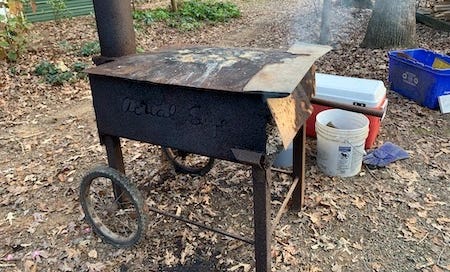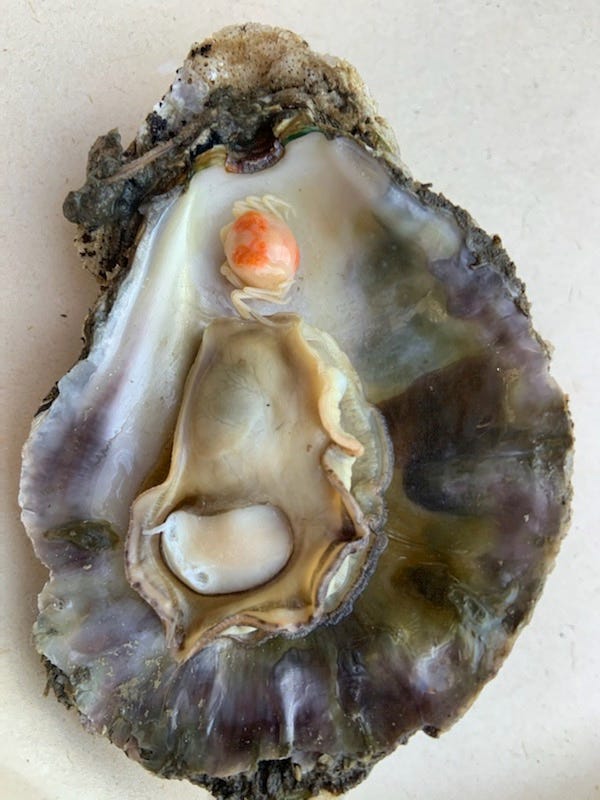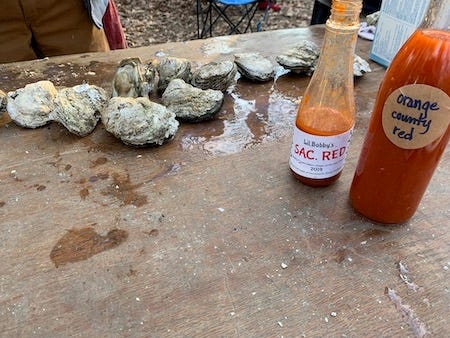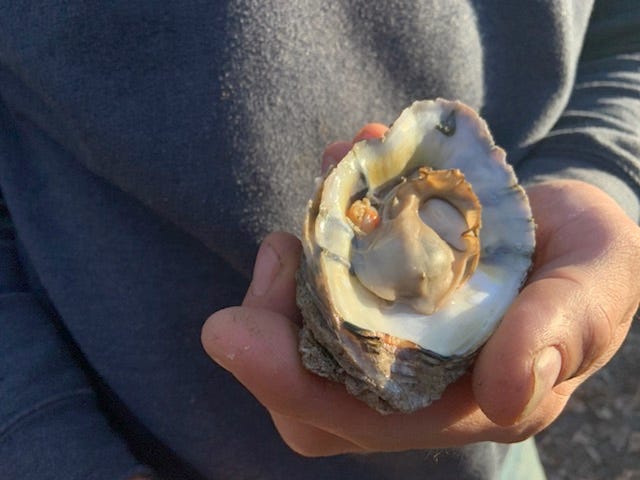The Sunday began with our friend Trip, rising early to dig fresh horseradish from his garden for the cocktail sauce. Food Pilgrim readers will remember Trip as the master of smoke and heat, the man who makes the best adobo in Orange County, North Carolina. He and L.A., culinary co-conspirators raised in Atlanta and trained via multiple feasting experiences in New Orleans, are also the makers of an annual incendiary device called “Orange County Red,” a sauce to set your head on fire. These condiments--along with a handcrafted mignonette sauce and lemon wedges--would soon be placed on a plywood tabletop set on sawhorses. Each household’s eating station was marked with a sticker on the plywood, safely distanced. Only eight of us would gather for the ritual. We each brought our own drinks, beer mostly, while L.A. had also set out freshly laundered towels at each station.
The day before, Donna and I, feeling somewhat virtuous in not having burned a whole tank of gas in a month, drove six plus hours roundtrip to Columbia, NC, to pick up the box of oysters. Willy Phillips, who runs Full Circle Seafood--a wholesale and retail operation on Highway 64 a couple miles past the Scuppernong River bridge on the way to Manteo--had suggested that we might like the cultivated oysters he’d lately been getting from the Core Sound in Carteret County.
I knew from our research for the December chapter of The Month of Their Ripening that the general consensus among connoisseurs was that the tastiest oysters in North Carolina tend to come in December, when they bulk up in colder waters. Many of the oyster experts also argued that the North and Newport rivers near Beaufort produce the best bivalves. Nowadays the list of cultivated or farmed oysters from that area is growing. Some of the newer, registered names are Bell’s Reef, Sea Cups, Wild Ponies, and Atlantic Emeralds.
Meanwhile, wild harvested oysters are becoming harder and harder to find along the coast. Before we headed east, I called The Sugar Shack--a restaurant and seafood seller at Nag’s Head--on the off chance that they might also have some Crab Sloughs, (pronounced slews), a locally revered wild oyster that grows near the mouth of Oregon Inlet where they are tossed about by rough Atlantic waters coming into the Sound. Sloughs are famous for the little crabs that often take up residence in the shell alongside the sweet and salty oyster meat.
“We only got in a half bushel total this year,” the Sugar Shack manager told me, with distress in her voice. “A whole lot of people were disappointed.” In a normal year, dozens of Outer Bankers would reserve Crab Sloughs by the bushel as a much-anticipated part of their Thanksgiving tradition.
“They just aren’t out there any anymore,” Willy confirmed, when I told him about my call to the restaurant. “But I have some wild caught oysters for you today,” he said, smiling behind his COVID mask. The oysters were from Gull Rock in Hyde County.
As Donna picked out ten pounds of the locally grown and remarkably sugary Covington sweet potatoes that Willy also sells in his shop, he went to retrieve the waxed box of oysters from one of the walk-in coolers out back where he also sets up shedders in soft-shell crab season. We were all set.
Trip’s oyster cooker Photos by Donna Campbell
By the time we arrived at Trip and L.A.’s house in the woods the next afternoon, the oak logs in Trip’s hand-welded oyster steamer had already become glowing coals. Sweet smoke rose from its tall chimney pipe. A few yards away, another knee-high, wrought-iron fire pit was blazing in the middle of a circle of mismatched outdoor chairs set wide apart. The smoke drifted around the circle as the group arrived.
At the appointed moment after everyone greeted from a distance and popped a can or cork, Trip dropped a dozen oysters like rocks on the steamer top and they sizzled. He dipped a thick burlap sack in water, threw it over the big shells, and we were in business. At three o’clock the sun was still warming the air to an agreeable 53 degrees under the tall pines and old hardwoods that surrounded us. We were ten-month captives of the pandemic, suddenly set free for a little while in the prison yard. We were garrulous and giddy.
Trip and L.A.’s son, Ernie, told us about his fishing exploits the day before on the Bay River down east. He’d brought home some nice-sized speckled trout. We talked about friends and elders who had suffered falls and other mishaps during the pandemic. L.A.’s resilient mother, in her 90s and confined to a rehab facility in Hillsborough, had been receiving family nearly every day outside the window of her first-floor room, sometimes passing written directives to her daughter through a narrow opening in the screen. Mostly the family mimed and smiled and laughed on these occasions, trying to keep everyone’s spirits up.
And who were any of us to complain this day? The first batch of oysters had begun to open. I tore into a box of saltines and set out a few sleeves on the plywood. Everyone stood and left the fire pit to take their places, towel in one hand, oyster knife in the other. Trip grabbed the burlap up and into a sling and transferred the oysters to the center of the table. They dripped and let off little clouds of steam.
The very first oyster Ernie opened had a tiny orange crab in it. “You eat that,” Trip said. “It’s good luck.” Then others of us began prying open our shells. There were more pea crabs alongside the plump and sweet oysters. The crabs, no bigger than the fingernail on my pinky, tasted like butter, though slightly crunchy. As it turned out, they were as reliable as the toy in a box of Cracker Jacks. According to food writer Jed Portman, they are the canary in the coal mine—a sign of good water and healthy oysters.
We ate through a half dozen batches of steamed oysters, one after another. We told stories. We laughed. We remembered past Decembers here in the woods, performing this ritual wrapped against much colder weather and in near dark with scores more friends and neighbors. Inside the house, the table would have been brimming with potluck dishes brought and soon emptied. But here we were, just a socially distanced, legally limited party. The best of friends.
Only a few oysters in the whole bushel hadn’t housed a little crab. Each one felt like a miracle. We didn’t need any other entrees or side dishes. We sampled the oysters with the cocktail sauce and fresh horseradish and nodded thanks to Trip as we slurped them down. L.A. had created the lovely mignonette with shallots and red wine vinegar and black pepper, elegant in its simplicity. Then we dug into the Orange County Red, and L.A.’s brother’s competing recipe called Little Bobby’s, made from peppers grown and cooked up in Portland, Oregon. The shells piled up under the table. I dipped the saltines in the sauces between oysters and felt the top of my head tingle.
"Can we eat the last batch?" Trip asked finally. Hell, yes, we could.
As darkness fell, we scattered back to our cars, full in every way. Christmas was coming and people in our community, despite our general prosperity, were going to be hungry. Two in our circle volunteered at the local food bank, where the lines were increasing, they’d said.
For days I’ve wondered if it might be unseemly to tell this story of oysters with the crab fortunes tucked inside. So much loss at the end of this terrible year of fear, this year of a record number of hurricanes and hospitals overcrowded.
Wild caught oysters are scarce. They are telling us something. The crabs, in their bounty, reminded us of the enduring magic of the natural world that we can either help or hinder going forward. How we move into the new year, together or not, is the question for us all.








